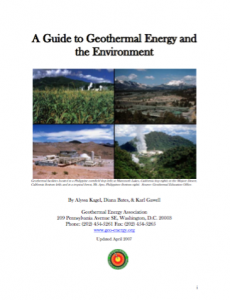Full Title: A Guide to Geothermal Energy and the Environment
Author(s): Alyssa Kagel, Diana Bates, and Karl Gawell
Publisher(s): Geothermal Energy Assocation
Publication Date: April 1, 2007
Full Text: Download Resource
Description (excerpt):
Geothermal energy, defined as heat from the Earth, is a statute-recognized renewable resource. The first U.S. geothermal power plant, opened at The Geysers in California in 1960, continues to operate successfully. The United States, as the world’s largest producer of geothermal electricity, generates an average of 15 billion kilowatt hours of power per year, comparable to burning close to 25 million barrels of oil or 6 million short tons of coal per year.
Geothermal has a higher capacity factor (a measure of the amount of real time during which a facility is used) than many other power sources. Unlike wind and solar resources, which are more dependent upon weather fluctuations and climate changes, geothermal resources are available 24 hours a day, 7 days a week. While the carrier medium for geothermal electricity (water) must be properly managed, the source of geothermal energy, the Earthís heat, will be available indefinitely.
A geothermal resource assessment shows that nine western states together have the potential to provide over 20 percent of national electricity needs. Although geothermal power plants, concentrated in the West, provide the third largest domestic source of renewable electricity after hydropower and biomass, they currently produce less than one percent of total U.S. electricity.
